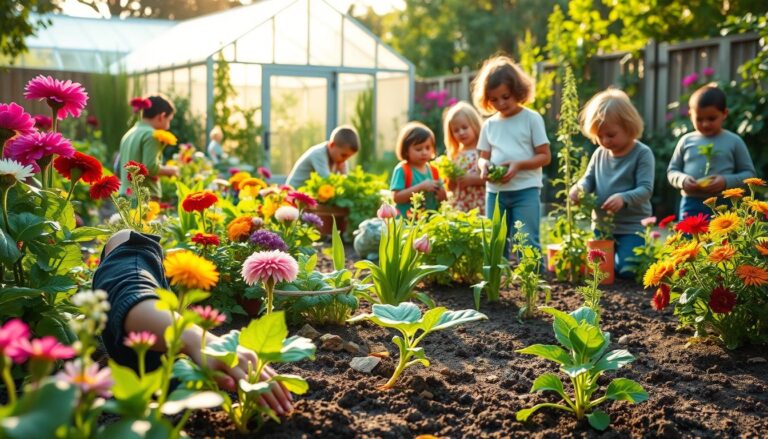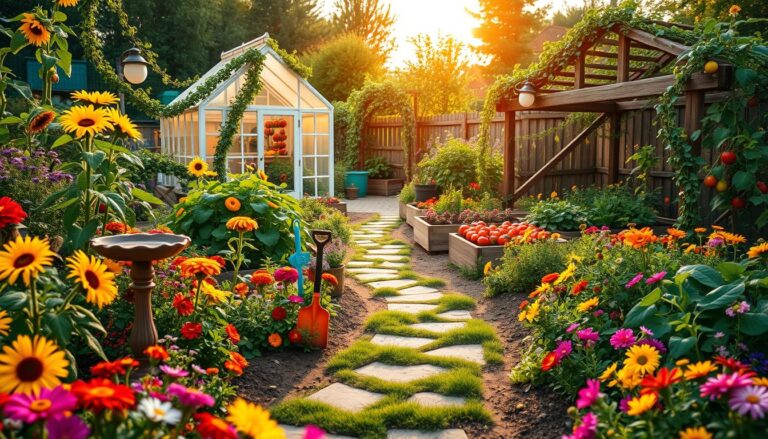To have vibrant plants, you need more than just a green thumb. You must understand plant care tips that help your plants grow well from root to leaf.
Good care is about finding the right mix of effective watering techniques and fertilizing methods. Learning these can help your plants flourish.
It’s important to know what your plants need. Each type of plant has its own water and nutrient needs. So, you must adjust your care to fit their needs.
By following the correct watering and fertilizing instructions, you can help your plants grow strong. And you’ll get to enjoy their beauty.
Understanding Your Plants’ Water and Nutrient Needs
To keep your plants thriving, it’s essential to understand their specific water and nutrient requirements. Different plants have evolved under various conditions, making their needs unique.
Different Plant Types and Their Requirements
The watering and fertilizing needs of plants vary significantly based on their type. Understanding these differences is crucial for effective plant care.
Succulents and Cacti
Succulents and cacti are adapted to dry environments and thus require less frequent watering. Overwatering is a common mistake that can lead to root rot.
Flowering Plants
Flowering plants often require more nutrients to support bloom production. Regular fertilization can enhance flowering.
Leafy Houseplants
Leafy houseplants need consistent moisture but can’t tolerate waterlogging. Balanced fertilization promotes healthy leaf growth.
| Plant Type | Watering Frequency | Fertilization Needs |
|---|---|---|
| Succulents & Cacti | Low | Low |
| Flowering Plants | Moderate | High |
| Leafy Houseplants | Moderate | Moderate |
Signs of Overwatering vs. Underwatering
Recognizing the signs of overwatering and underwatering is vital. Overwatering can lead to yellowing leaves and root rot, while underwatering causes dry, crispy leaves.
Adjusting your watering schedule based on these signs can significantly improve your plant’s health.
The Science Behind Effective Watering Techniques
Knowing the science of watering is key to keeping plants healthy and vibrant. It’s not just about how much water you use. It’s also about the water quality, timing, and method.
Watering is a complex process. It involves understanding your plants, the soil, and the environment. By mastering watering, gardeners can improve plant health, save water, and garden more sustainably.
Water Quality and Its Impact on Plant Health
The water quality affects plant health a lot. Tap water can have chlorine, fluoride, and minerals that harm growth. Using filtered or rainwater can help.
Also, the water’s pH level matters. Most plants like a pH between 6.0 and 7.0. Water that’s too alkaline or acidic can stress plants, making them more vulnerable to disease and pests.
Best Times of Day for Watering
When you water is important too. Watering in the early morning or late evening helps plants stay moist. Avoid watering when it’s hottest to prevent plant stress.
Deep Watering vs. Light Watering
Deep watering means watering until the soil is moist several inches deep. This promotes deep roots, making plants more drought-resistant. On the other hand, light watering leads to shallow roots, making plants more prone to water stress.
| Watering Technique | Benefits | Drawbacks |
|---|---|---|
| Deep Watering | Encourages deep root growth, reduces watering frequency | May require more initial effort |
| Light Watering | Easier to implement, less initial effort | Can lead to shallow root growth, increased watering frequency |
By applying these principles, gardeners can create a better watering plan. This supports plant health and follows best practices in garden care and fertilizing.
Complete Watering and Fertilizing Instructions for Different Plant Types
Watering and fertilizing are key to plant care. They change a lot depending on the plant type. Knowing these differences helps keep plants healthy and strong.
Indoor Plants
Indoor plants need the right amount of water and food to grow well. Too much water can harm them, causing root rot and other problems.
Watering Frequency for Common Houseplants
Most houseplants like their soil to dry a bit before watering again. For instance, Snake Plants and ZZ Plants can go a long time without water. But Ferns and Peace Lilies need more water often.
Fertilizer Schedule for Indoor Plants
Indoor plants grow better with regular food during the growing season. A balanced fertilizer with a 20-20-20 NPK ratio works well for most. Feed them every 4-6 weeks in spring and summer.
Outdoor Gardens
Outdoor gardens, like vegetable patches, herb gardens, flower beds, and ornamental areas, need different care than indoor plants.
Vegetables and Herbs
Vegetables and herbs need steady moisture, especially when they’re producing fruit. Deep watering once or twice a week is better than shallow daily watering.
Flowers and Ornamentals
Flowers and ornamentals do well with regular watering and food. Cutting off spent blooms can help them flower more.
Trees and Shrubs
Trees and shrubs don’t need to be watered as often as other plants. But they do benefit from deep watering during dry times.
“The best way to water trees is to water deeply and infrequently to encourage deep root growth.”
Essential Watering Tools and Equipment
Effective watering starts with the right equipment. The right tools make the task easier and ensure your plants get the right water.
To water plants right, knowing the tools is key. Here are some of the most useful ones:
Watering Cans and Hose Attachments
Watering cans are simple yet effective for indoor plants or small gardens. They let you control the water amount precisely. Hose attachments are great for bigger gardens, watering many plants at once efficiently.
Moisture Meters and Rain Gauges
Moisture meters show the soil’s moisture level, removing the guesswork from watering. This prevents over or underwatering your plants. Rain gauges measure rainfall, helping you adjust your watering schedule.
Smart Irrigation Controllers
Smart irrigation controllers offer a more advanced solution. They adjust watering based on weather, soil moisture, and plant needs. This optimizes water use and cuts waste.
Using these essential tools in your watering routine will help keep your garden or indoor space healthy and vibrant.
Garden Watering Systems and Methods
It’s important to know about the different garden watering systems and methods. This ensures your plants get the right amount of water. A good watering system saves water and helps plants grow well.
Drip Irrigation Benefits and Setup
Drip irrigation is very efficient. It waters plants right at their roots, cutting down on evaporation and runoff. To set up a drip system, lay out the tubing along your plants. Use a pressure regulator to make sure the water pressure is right.
Gardening expert says, “Drip irrigation is a game-changer for water conservation in gardens.”
“Drip irrigation is a game-changer for water conservation in gardens.”
Sprinkler Systems: Pros and Cons
Sprinkler systems are also popular for watering gardens. They can be set up to water big areas and are good for large gardens. But, they might not be as efficient because of evaporation and overspray.
When picking a sprinkler system, think about the type of sprinkler heads and how they’re laid out. This helps avoid wasting water.
- Pros: Covers large areas, can be automated
- Cons: May lead to evaporation and overspray
Hand Watering Techniques for Gardens
Hand watering lets you control how much water each plant gets. It’s great for small gardens or plants that need extra care. To water by hand, water at the base of the plants. This keeps the leaves dry and prevents disease.
Knowing about different watering systems helps you pick the best one for your garden. This ensures your plants do well and you save water. Choosing the right watering system is key to keeping your garden healthy and beautiful.
Understanding Plant Nutrition and Fertilizer Types
The secret to healthy plants is knowing about plant nutrition and picking the right fertilizers. Plant nutrition is complex, needing many nutrients for growth. A balanced fertilizer gives plants what they need to grow well.
The plant nutrition guide says it’s key to know what your plants need. “A well-nourished plant can fight off diseases and pests better. It also does well in tough conditions.”
NPK Ratios Explained
Fertilizers have an NPK ratio, showing the nitrogen (N), phosphorus (P), and potassium (K) levels. These nutrients are crucial for growth. Nitrogen helps leaves grow, phosphorus aids roots and flowers, and potassium boosts overall health.
Organic vs. Synthetic Fertilizers
The debate on organic vs. synthetic fertilizers is ongoing. Organic fertilizers come from nature and release nutrients slowly, improving soil. Synthetic fertilizers work fast but can harm the environment if used too much. The best fertilizing techniques often mix both, based on plant needs and gardener’s choice.
“Using organic fertilizers can make gardening more sustainable. It improves soil and supports biodiversity.”
Slow-Release vs. Quick-Release Options
Fertilizers differ in how they release nutrients. Slow-release fertilizers give nutrients over time, needing less frequent use. Quick-release fertilizers provide nutrients right away but might need more frequent use. The choice depends on the plant’s stage and the gardener’s schedule.
Knowing about different fertilizers helps gardeners choose the best fertilizing techniques for their plants. With a plant nutrition guide, gardeners can care for their plants effectively.
Seasonal Watering and Fertilizing Guide
To keep your plants thriving, adjust your watering and fertilizing schedule with the seasons. Each season has its own challenges and opportunities for plant care. Knowing these needs is key to keeping your plants healthy and vibrant.
Spring and Summer Care
In spring and summer, plants grow fast and need more water and nutrients. You should water and fertilize them more often during these times.
Spring Awakening Techniques
In spring, start with gentle watering to help plants wake up from winter. Use a balanced fertilizer to encourage new growth. For organic options, try compost or compost tea to enrich your plants’ diet.
Summer Heat Management
Summer heat can be tough on plants. Water deeply but infrequently to help them grow strong roots. Use drip irrigation or soaker hoses for efficient watering.
Fall and Winter Adjustments
As fall and winter come, plants need less water and nutrients. They’re getting ready to rest.
Fall Preparation
In fall, reduce watering to help plants prepare for winter. Keep fertilizing, but use a fertilizer with less nitrogen. This helps with root growth and hardiness.
Winter Dormancy Care
In winter, most plants are dormant and need little water and no fertilizing. Check on them now and then to make sure they’re okay.
| Season | Watering Frequency | Fertilizing Needs |
|---|---|---|
| Spring | Increase frequency | Balanced fertilizer |
| Summer | Deep but infrequent | High nitrogen |
| Fall | Reduce frequency | Lower nitrogen |
| Winter | Minimal | No fertilizing |
Sustainable Watering Practices for Drought Conditions
Droughts need careful watering to save plants and water. As water gets scarcer, gardeners must find ways to use less water. This helps keep gardens healthy and green.
Water Conservation Techniques
Water saving is crucial for gardens in drought. Drip irrigation is a top method. It sends water straight to the roots, cutting down on evaporation and runoff.
Using mulch around plants also helps. It keeps the soil moist and cuts down on watering needs. Installing rain barrels to catch rainwater is another smart move. It helps use less tap water.
- Implement drip irrigation systems to reduce water waste.
- Apply mulch around plants to retain moisture.
- Use rain barrels to collect rainwater for garden use.
Drought-Resistant Landscaping
Choosing drought-tolerant plants is key for gardens in dry areas. These plants can survive with little water. They often have deep roots or special leaves to save water.
Adding native plants to your garden is also smart. They need less water and care, and they help local wildlife.
By using water-saving methods and drought-resistant plants, gardens can stay strong even in dry times.
Organic Fertilizing Methods for Eco-Conscious Gardeners
Organic fertilizing methods are good for the soil and the environment. They help gardeners grow plants in a way that’s kind to the planet.
Compost and Compost Tea Applications
Compost and compost tea are great for making soil healthy. Compost tea is made by soaking compost in water. It adds good microbes to the soil, helping plants grow well.
To use compost tea, mix it with water as suggested, usually 1:10. Spray it on plants or soak the soil with it.
Natural Amendments and Their Benefits
Natural additives like bone meal, fish emulsion, and alfalfa meal are full of nutrients. They help the soil and plants without harming the environment. These additives give plants the nutrients they need slowly, avoiding too much fertilizer.
Bone meal, for example, is rich in phosphorus. It’s perfect for plants that need it, like flowers and trees.
DIY Organic Fertilizer Recipes
You can make your own organic fertilizers at home. One easy mix is eggshells and Epsom salt. It’s a calcium-rich fertilizer for plants.
Another way is to brew coffee grounds in water. This makes a liquid fertilizer full of nutrients. These best fertilizing techniques save money and cut down on waste.
Conclusion: Creating a Sustainable Watering and Fertilizing Routine
By following the guidelines in this article, you can create a routine that helps plants grow well and is good for the environment. It’s important to know what your plants need, water them right, and use fertilizers wisely.
Think about the type of plant, the climate, and the soil when planning your routine. This way, you can make sure your plants are happy and healthy. You’ll also be helping the planet by using less resources.
By using these tips, you’ll become a great gardener. You’ll learn how to take care of your plants in a way that’s good for the planet.
FAQ
How often should I water my indoor plants?
What is the best fertilizer for flowering plants?
How can I prevent overwatering my plants?
What are the benefits of using drip irrigation for my garden?
Can I use synthetic fertilizers on my organic garden?
How do I know if my plants are getting enough nutrients?
What is the best time of day to water my plants?
How can I make my own organic fertilizer at home?

Sortemdia nasceu com o propósito de trazer alegria e oportunidades para todos por meio de sorteios gratuitos de prêmios incríveis. O site tem como missão oferecer experiências acessíveis, divertidas e justas para quem deseja concorrer a produtos, serviços e brindes sem pagar nada por isso. Acreditamos que a sorte pode bater à porta de qualquer pessoa — e no Sortemdia, ela pode chegar com apenas um clique.



